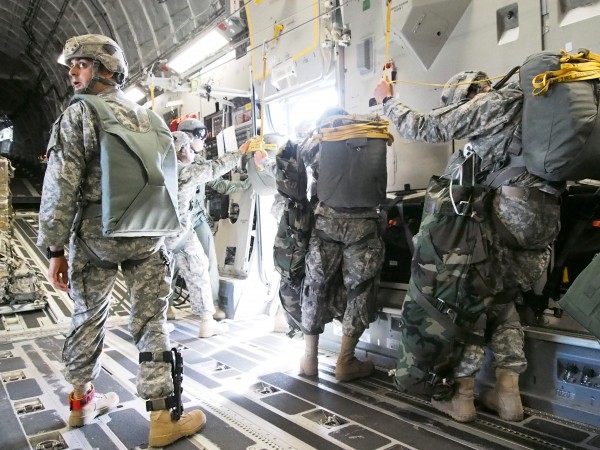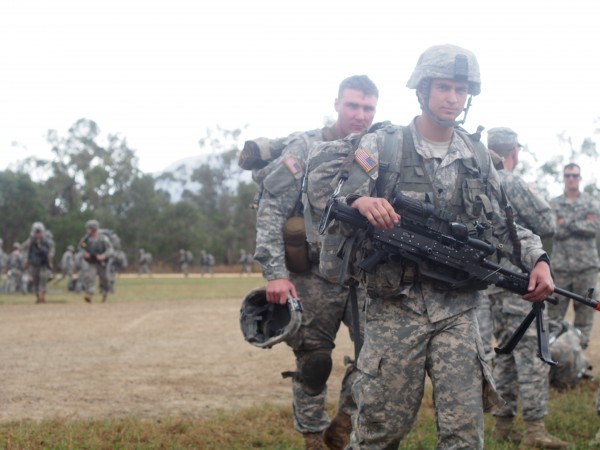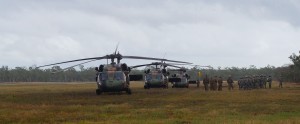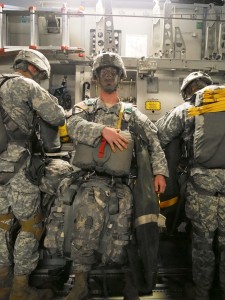This week, U.S. Army Alaska troops based at JBER have been taking part in a massive training exercise stretching from Alaska to Australia. Operation Talisman Saber involves over 33,000 military personnel from three continents. And the airborne unit playing lead in one of the several ongoing exercises in the Pacific theater is slated for cutbacks that exemplify the Army’s changing global mission.

It’s hard to grasp the scale of Talisman Saber, an operation with months of planning, designed around daylong rides inside massive cargo planes shuttling troops across the globe. Major Kim Edhegard is one of about 500 airborne soldiers from the 425th combat brigade parachuting in to a remote training zone on the eastern edge of Australia.
“It feels like jumping off the bed of a truck with your eyes closed,” Edhegard said in the cargo hold of a C-17 plane–one of seven taking part in just a piece the multinational exercise.
Talisman Saber has happened every two years since 2005 to bolster relationships between the U.S. military and it’s partners in the Pacific, specifically Australia. The goal is to be able to drop an instant fighting force on the other side of the world within 24 hours.

And while it’s a drill, it feels extremely realistic watching dozens of soldiers check and recheck hundred-pound piles of equipment in the hours before they jump off the plane.
Staff Sergant Thomas Gutierrez is a jumpmaster. It’s his job to check chutes, get jumpers prepped, and keep them as safe as circumstances allow.
“You have to be strong-willed,” Gutierrez explained. “Your confidence and your attitude reflects the confidence of the jumper.
Like all thee jumpmasters on board, Gutierrez carries two pieces around his ankle: a fluorescent band with his name, and a large knife in case he has to cut the tangled parachute cord of a snagged jumper. “The more direct, the louder you are, the more confidence the jumpers will have in you knowing that everything will go right.”
It’s a short ride down: jumpers exit just 1,000 feet from the ground, a distance that’s close enough to make out individual tree trunks through the open sidedoors.
Today there are just five injuries—well below the 2-4 percent casualty rate that Gutierrez and others expect on this kind exercise.

“This is one of the safest things you can do, if done properly,” Gutierrez said. “Everything is done in a repetitive motion, over and over again, to where it becomes second nature to us. But the smallest mistake could be catastrophic, like life threatening.”
After the first few dozen jumpers vanish out into the sun and wind, the plane makes another pass over the landing zone. Specialist Jordan Dunn is on deck, sitting under his giant rucksack with a machine gun fastened to his hip.He wasn’t nervous, but eager to get out of the plane after so many long hours.
“I just wanna take all this gear off,” Dunn said. “It’s probably the best feeling in the world–in the air, when you let go of everything.”

Once Dunn and the last few jumpers landed, they joined a mock battle down below.
The long, complicated, dangerous exercise begs the question: why do any of this at all?
Even on a good day there are injuries, the worst being a broken femur requiring helicopter transport Wednesday.
It’s also expensive, with a price tag of $23 million for costs like fuel, thousands of field rations, and $200 disposable parachutes for dropping over a ton of blank ammo and medical equipment into the mock landing zone. Given a shrinking military and diminishing federal budgets, why bother?
“A big part of it is just the capability,” explained Lieutenant Colenel Matt Haradman. “It’s a deterrent to our adversaries, but it’s also reassurance to our allies.”
Hardman is in charge of the battalion taking lead on the airborne piece of Talisman Saber. We spoke in the field (literally a giant, grassy field) his troops seized hours earlier, surrounded by hundreds of sleeping bags–soldiers bedded down for the night.
Airborne operations have been uncommon in the decades since World War II, although there are a handful of publicly acknowledged, small-scale drops in Iraq, Afghanistan and elsewhere. But the capability is far from a staple in the U.S.’s contemporary arsenal. Hardman and others believe maintaining the capacity to pull off airborne missions takes practice runs, which doubly serve to build relationships with military allies.
“In the 21st century, everything we’re going to do is going to be joint and is going to be multinational–that’s just the nature of where we’ve gone,” Hardman said. “All the work that goes into this exercise is exactly what I saw in my four deployments in Afghanistan and Iraq.”

That spirit of camaraderie and cooperation is on full display by morning. In between quick bursts of rain, intermittent rainbows, and the occasional kangaroo sighting in the distance, the Australian and American troops lined up for a wing exchange ceremony.
“When one nation of paratroopers jumps with another nation of paratroopers they exchange their wings,” yelled Lieutenant Colonel Jeff Crapo to several hundred troops. “When you exit that aircraft it takes a special individual to turn and face the door and jump out of that thing. And today we share that with our Australian brethren.”
After the exercise finished and soldiers were ferried back to Amberly Airforce base an hour south towards Brisbane, troops started seeing news on their cellphones that this airborne unit stands to take one of the largest cuts of any brigade in the Army as part of a nationwide drawdown. By the time the time 4-25th is scaled back they’ll be a third of their current size, but still have the numbers and know-how to run the next iteration of Talisman Saber in 2017.
Zachariah Hughes reports on city & state politics, arts & culture, drugs, and military affairs in Anchorage and South Central Alaska.
@ZachHughesAK About Zachariah




